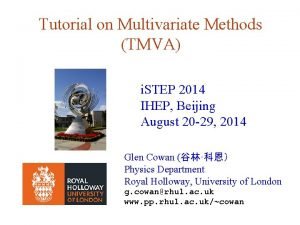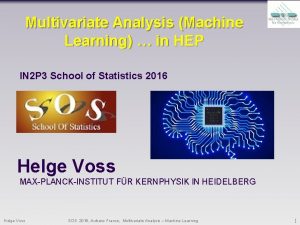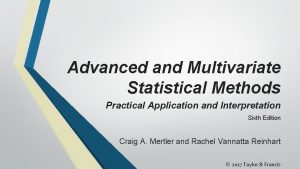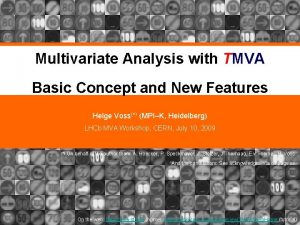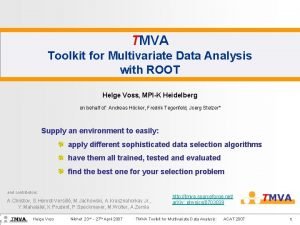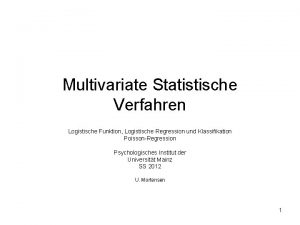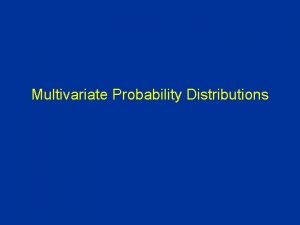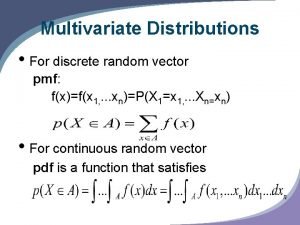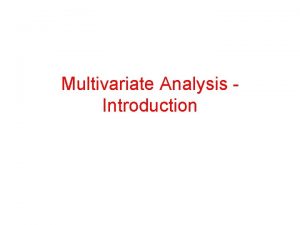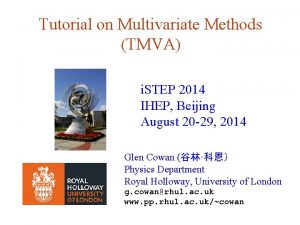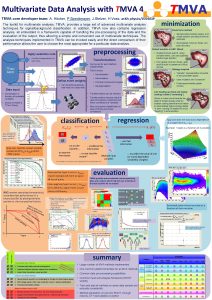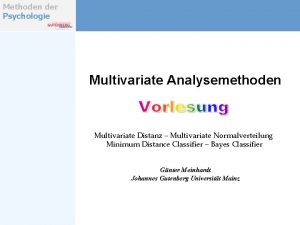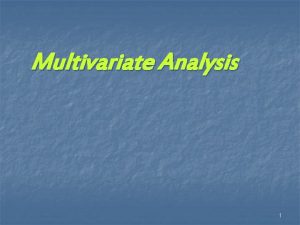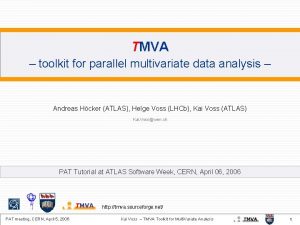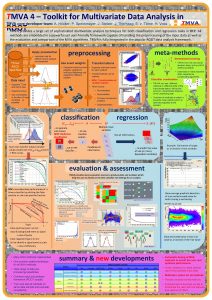Tutorial on Multivariate Methods TMVA i STEP 2014











- Slides: 11

Tutorial on Multivariate Methods (TMVA) i. STEP 2014 IHEP, Beijing August 20 -29, 2014 Glen Cowan (谷林·科恩) Physics Department Royal Holloway, University of London g. cowan@rhul. ac. uk www. pp. rhul. ac. uk/~cowan G. Cowan i. STEP 2014, Beijing / TMVA Tutorial 1

Introduction Exercise: use samples of “toy” signal/background MC training data to train a multivariate classifier using the program TMVA. Problem sheet on: www. pp. rhul. ac. uk/~cowan/stat/beijing 14/ istep_tmva_problem. pdf Code for exercise: www. pp. rhul. ac. uk/~cowan/stat/root/tmva/ tmva. Examples. tar Download to local directory and unpack: tar –xvf tmva. Examples. tar Setup for Root/TMVA at IHEP: source /home/atlas 01/bin/root/bin/thisroot. sh Read the file readme. txt for more instructions. G. Cowan i. STEP 2014, Beijing / TMVA Tutorial 2

Each event characterized by 3 variables, x, y, z: G. Cowan i. STEP 2014, Beijing / TMVA Tutorial 3

Test example (x, y, z) y y no cut on z z < 0. 75 x y z < 0. 25 z < 0. 5 x G. Cowan i. STEP 2014, Beijing / TMVA Tutorial x 4

Test example results Fisher discriminant Multilayer perceptron Naive Bayes, no decorrelation Naive Bayes with decorrelation G. Cowan i. STEP 2014, Beijing / TMVA Tutorial 5

Extension of ATLAS Project select For the ATLAS Group Project, you defined a test statistic t to separate between signal (tt. H) and background events. tcut t You selected events with t > tcut, calculated s and b, and estimated the expected discovery significance using s/√b. This is OK for a start, but does not use all of the available information from each events value of the statistic t. G. Cowan i. STEP 2014, Beijing / TMVA Tutorial 6

Likelihood ratio statistic for discovery test In bin i of test statistic t, expected numbers of signal/background: Likelihood function for strength parameter μ with data n 1, . . . , n. N Statistic for test of μ = 0: (Asimov Paper: CCGV EPJC 71 (2011) 1554; ar. Xiv: 1007. 1727) G. Cowan i. STEP 2014, Beijing / TMVA Tutorial 7

Background-only distribution of q 0 For background-only (μ = 0) toy MC, generate ni ~ Poisson(bi). Large-sample asymptotic formula is “half-chi-square”. G. Cowan i. STEP 2014, Beijing / TMVA Tutorial 8

Background-only cumulative distribution of q 0 p-value is probability, assuming μ = 0, to find q 0 even higher than the one observed (one minus cumulative distribution). From p-value, equivalent significance: Z = Φ-1(1 – p) Φ-1 = standard normal quantile G. Cowan i. STEP 2014, Beijing / TMVA Tutorial 9

Discovery sensitivity Good agreement between toy MC and large-sample formulae, so OK to use asymptotic formula for significance Z, Median significance of test of background-only hypothesis under assumption of signal+background from “Asimov data set”: You can use the Asimov data set to evaluate q 0 and use this with the formula Z = √q 0 to estimate the median discovery significance. G. Cowan i. STEP 2014, Beijing / TMVA Tutorial 10

Multinomial model Nominal ATLAS analysis uses the information from the distribution of the MVA ouput (“shape information”). No info is taken from the total observed number of events (presumably because the systematic uncertainty on b is large). This corresponds to using a multinomial model for the observed histogram of MVA output values: G. Cowan i. STEP 2014, Beijing / TMVA Tutorial 11
 Step 1 step 2 step 3 step 4
Step 1 step 2 step 3 step 4 Tmva tutorial
Tmva tutorial Multivariate methods in machine learning
Multivariate methods in machine learning Advanced and multivariate statistical methods
Advanced and multivariate statistical methods Tmva user guide
Tmva user guide Tmva user guide
Tmva user guide Inlay wax pattern fabrication
Inlay wax pattern fabrication Multivariate logistische regression
Multivariate logistische regression Multivariate binomial distribution
Multivariate binomial distribution Multivariate pdf
Multivariate pdf What is multivariate analysis?
What is multivariate analysis? Mahalanobis distance spss
Mahalanobis distance spss

